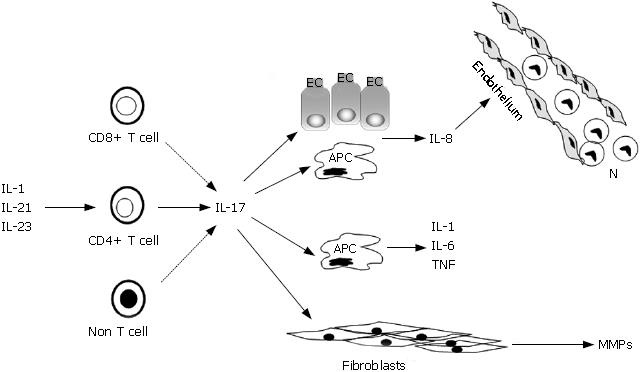Copyright
©2007 Baishideng Publishing Group Inc.
World J Gastroenterol. Nov 14, 2007; 13(42): 5547-5551
Published online Nov 14, 2007. doi: 10.3748/wjg.v13.i42.5547
Published online Nov 14, 2007. doi: 10.3748/wjg.v13.i42.5547
Figure 1 The figure illustrates some of the putative functions of IL-17 in the human gastric mucosa.
During H pylori infection, IL-17 is produced by both lamina propria (LP) T (CD4+ and CD8+) and non- T cells, through a process that could be positively regulated by IL-1, IL-21, and IL-23. IL-17 stimulates both epithelial cells (EC) and LP antigen presenting cells (APC) to make IL-8, thereby enhancing the recruitment of blood neutrophils (N) into the mucosa. Additionally, IL-17 increases the production of inflammatory cytokines, such as IL-1, IL-6, and TNF by LP APC, as well as it stimulates fibroblasts to secrete matrix metalloproteinases (MMPs), a family of proteases that can cause mucosal degradation.
-
Citation: Caruso R, Pallone F, Monteleone G. Emerging role of IL-23/IL-17 axis in
H pylori -associated pathology. World J Gastroenterol 2007; 13(42): 5547-5551 - URL: https://www.wjgnet.com/1007-9327/full/v13/i42/5547.htm
- DOI: https://dx.doi.org/10.3748/wjg.v13.i42.5547









